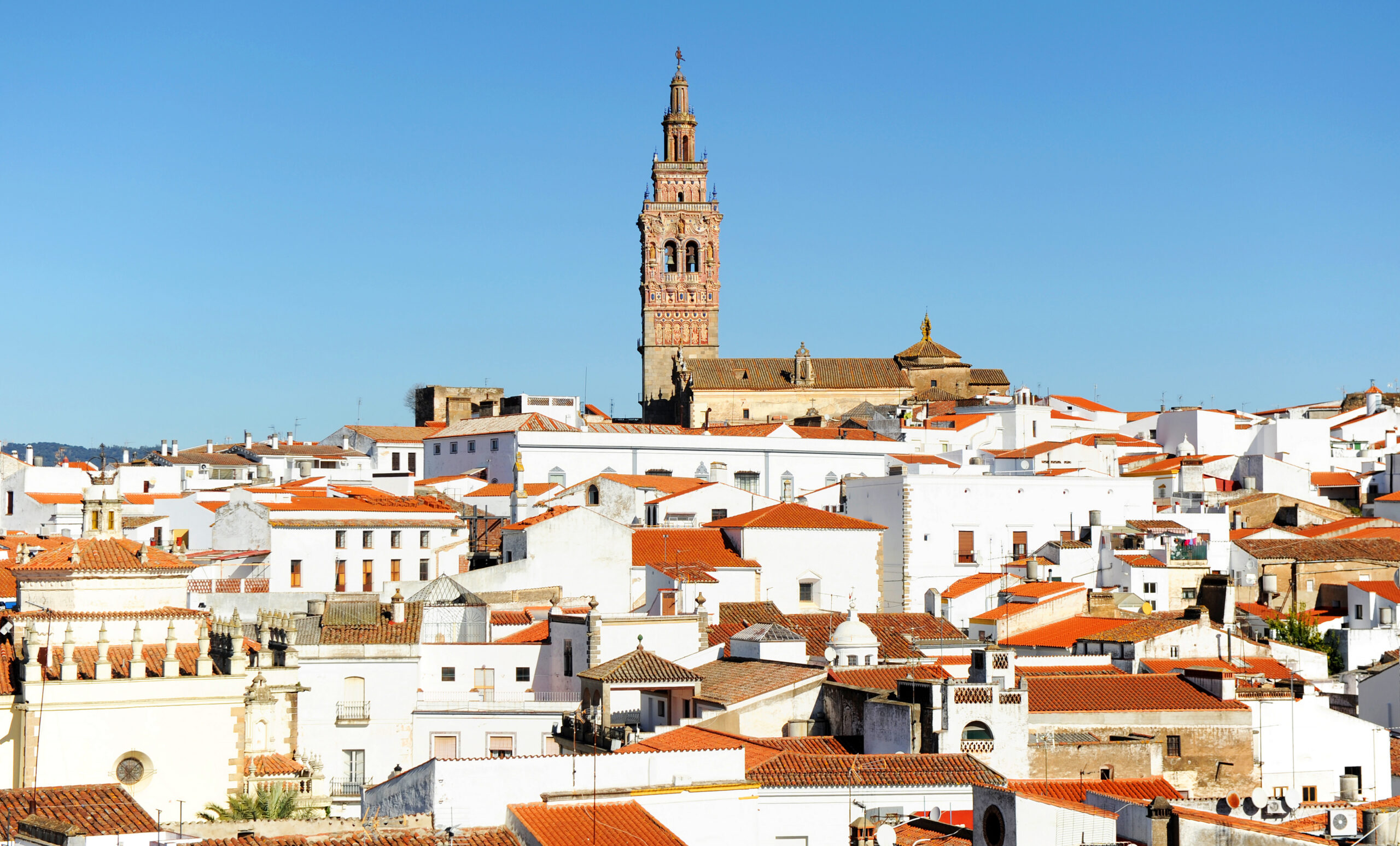The west of Spain is one of the lesser-known destinations in central Spain. The region is ideal for individual tours off the beaten track. The hilly landscapes have a very special charm. Pigs, cattle and sheep graze on the green meadows in the shade of oak trees. Vultures circle under the blue sky. Storks build their nests on church towers and electricity pylons along the roads.
Large cities are the exception here, as Extremadura is one of the most sparsely populated regions in Europe. The Roman city of Mérida and the medieval city of Cáceres are interesting city destinations. No less attractive are the picturesque small towns such as Trujillo or Guadalupe, which tell a lot about Spain’s history.
In our article about Extremadura you will find the most beautiful destinations for a vacation in western Spain.
Monfragüe National Park
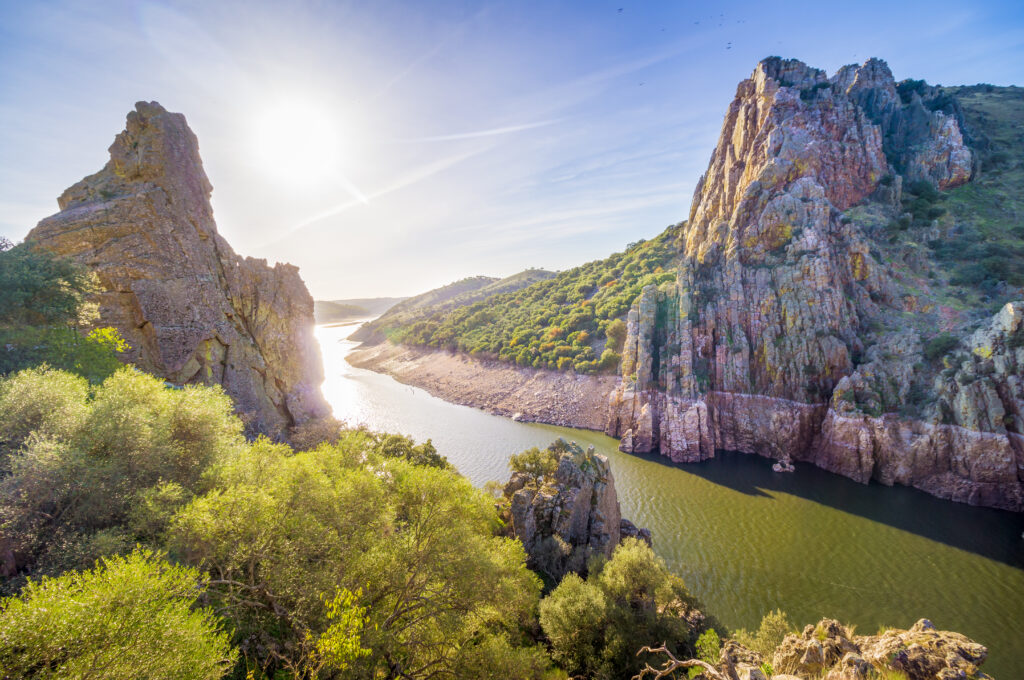
Monfragüe is considered to be the best preserved Mediterranean hilly landscape in the world. Mountainous oak and Mediterranean forests as well as rock formations, river courses and reservoirs provide an ideal habitat for both animals and plants, which is reflected in the impressive and species-rich flora and fauna.
A visit to the Vulture Rock (Salto del Gitano) is overwhelming. Among other things, around 80 pairs of griffon vultures, 3 pairs of black storks and a pair of royal eagles are said to nest there. Not far from the Vulture Rock, in the direction of Trujillo, there is a castle on the left-hand side, the Castillo de Monfragüe. From its lookout towers, you can literally feel the vastness of the land and the unique nature. A circular hiking trail that leads past both viewpoints is also very attractive.
The route from Villareal de San Carlos to Saltos de Torrejón is extremely impressive and varied by car, passing the reservoir via the EX-208 to La Bazagona, past other spectacular viewpoints.
Not only birdwatchers, biologists, geologists, hikers or nature lovers in general will get their money’s worth here. Astrologers and romantics will also be rewarded with a seemingly endless starry sky when they visit at night.
Guadalupe
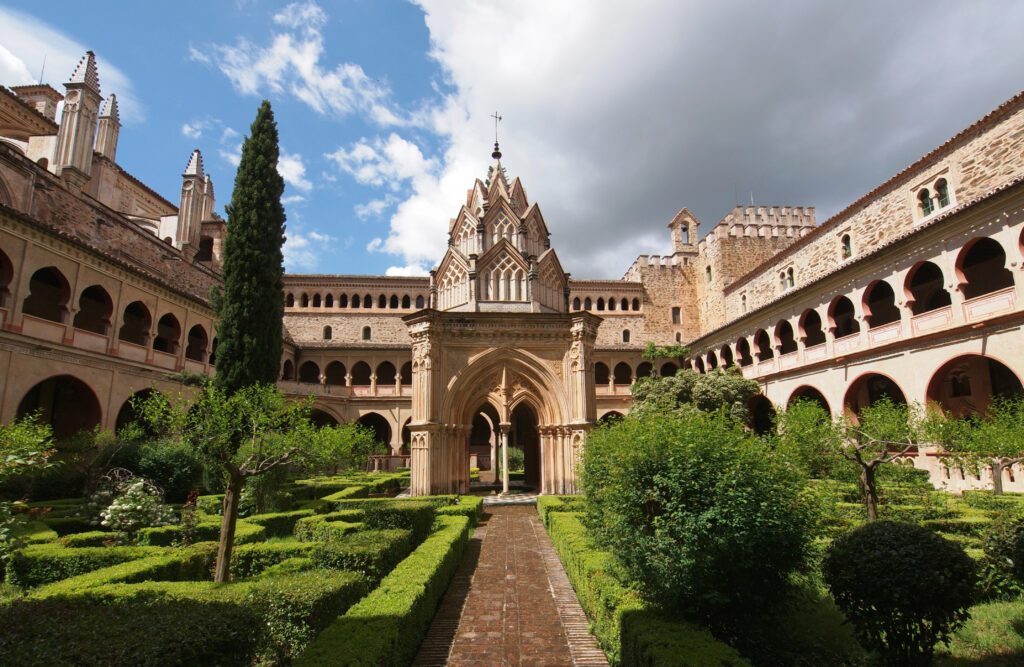
The small mountain town of Guadalupe, which has a population of just over 2,000, lies at an altitude of over 600 meters on the edge of the Sierra de Guadalupe in the east of Extremadura.
The history of the most important pilgrimage destination in the historic Kingdom of Castile begins with the chance discovery of a statue, in this case of the Virgin of Guadalupe, by a shepherd. According to legend, the statue of the Virgin had been hidden on the banks of the River Guadalupe many centuries before from the Moorish conquerors.
The fact that the image of the Virgin survived the Moorish occupation in one piece apparently demonstrated a particular resilience and fired the imagination of Castilian King Alfonso XI. He appealed to the Virgin of Guadalupe for support in the fight against the Moors.
The name of the monastery and Our Lady of Guadalupe are inextricably linked with the Spanish campaigns of conquest in America and Asia. The Catholic kings Isabella I of Castile and Ferdinand II of Aragon welcomed Christopher Columbus here in 1486 and 1489, who later named one of the Caribbean islands he discovered Guadalupe (today better known by its French name Guadeloupe).
The monastery complex, designed like a fortress, is one of the most impressive examples of the Mudejar style in Spain. The latter was a major reason for its inclusion in the UNESCO World Heritage List. The outstanding sights include the monastery church and the cloister.
Trujillo
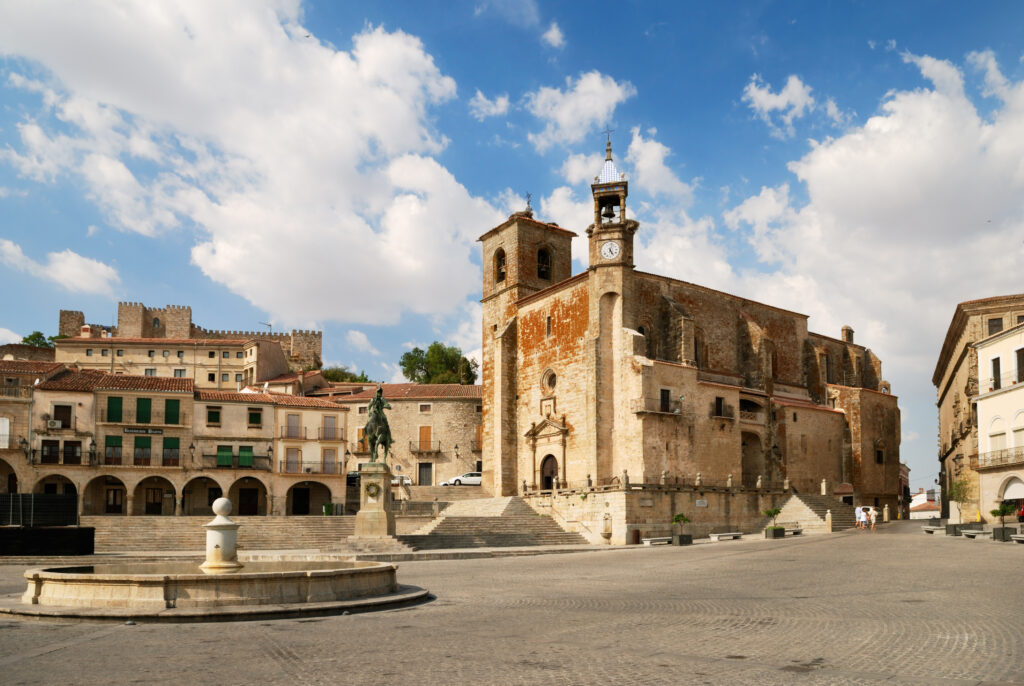
The Spanish city of Trujillo is located in the province of Caceres at an altitude of 564 meters above sea level. This makes it possible to enjoy a wide view over the region, which was certainly very useful for the Romans who arrived here in the 2nd century.
Trujillo is also known in history for its conquistadors, the Spanish term for conquerors. There were 56 of them here and all of them were involved in the conquest and discovery of Central and South America.
Anyone vacationing in the region or interested in the history of the country as a tourist will find many sights of historical value in Trujillo. Around 9,600 inhabitants live here and the city’s history has also witnessed Arab rule. It was taken in 1186 and reconquered a few years later by Christian knights. There are still monumental witnesses to this period that are well worth seeing for modern tourists.
The monument on the Plaza Mayor commemorates the Pizarros, the old town with palaces that also date back to the Conquista period and the 13th century church of Santa Maria da Mayor are popular sights for tourists. The castle, which was built above the town and has stood there since the 13th century, is now only occupied by peaceful visitors.
Cáceres
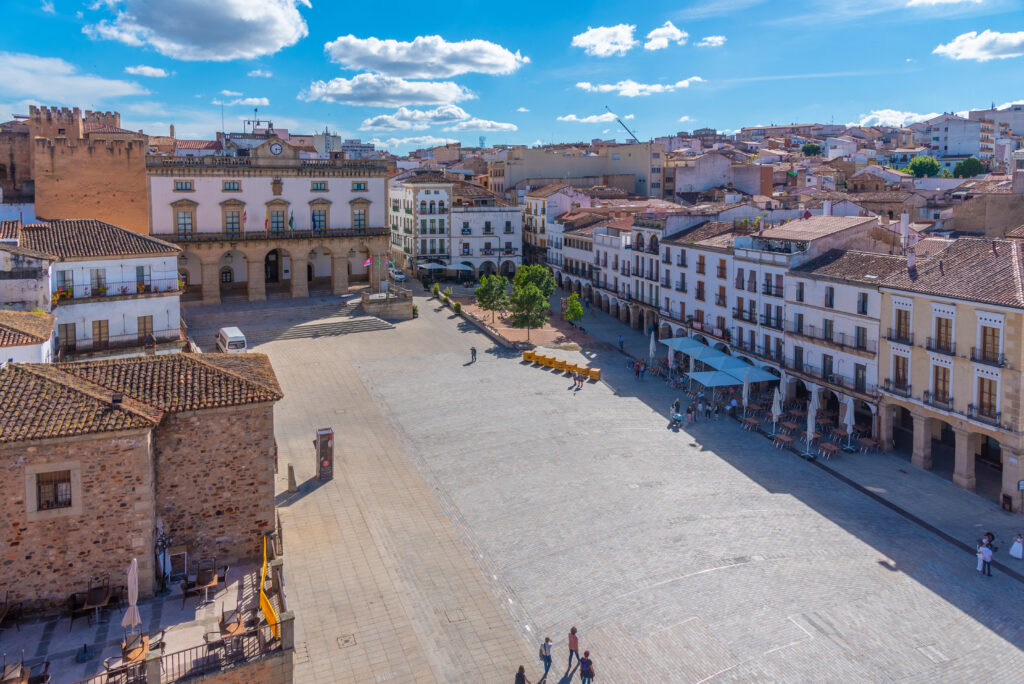
Caceres has an important old town, which has been declared a UNESCO World Heritage Site. It is filled with many sights and the surrounding area of Caceres also has a lot to offer visitors.
The origins of Caceres go back to the Roman fortress, which was built in 79 BC by Caecilius Metellus Pius around 2.5 km north-east of the current urban area. There was also a Celtiberian settlement called Colonia Norbensis Caesarina in the vicinity of Caceres as early as 35 BC.
It was founded by the Roman proconsul Gaius Norbanus Flaccus. In the 6th century, the town was destroyed by the Visigoths and later rebuilt by the Moors. Other rulers also influenced the town in the following years, such as King Leon, Ferdinand II and Geraldo the Fearless.
Visitors mainly flock to the old town, which is divided into an inner and outer area by a wall. The historic old town is located within the walls. This is where the majority of Caceres’ historic buildings are located. There are also different zones within the wall, such as the Santa Maria district.
Here you will find palaces, villas and noble houses. The Palacio de Carvajal can be visited with its interior rooms, courtyard and garden. The Casa Museo Guayasamin and the largest cistern in the world are also interesting places to visit.
Merida
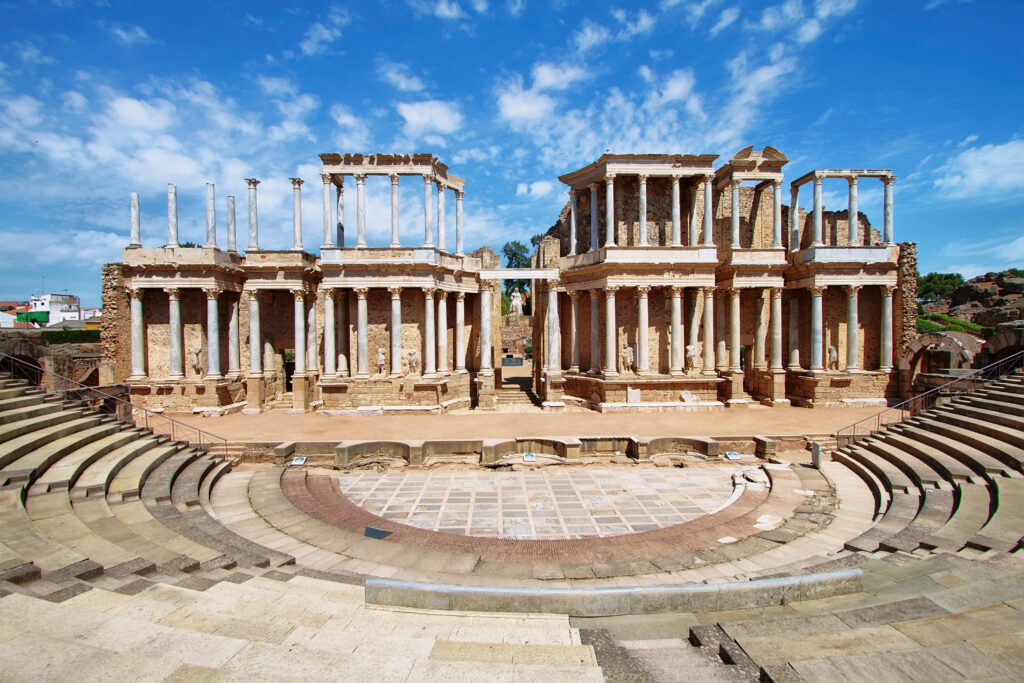
A trip to the city of Mérida in the province of Badajoz is a must on a tour of Extremadura. As the capital of the autonomous region of Extremadura, it has an impressive number of historical buildings, some of which are UNESCO World Heritage Sites.
Significant evidence of Roman culture can be found throughout the old town. The best-preserved Roman monument ensemble in the world is located in Mérida. It consists of an impressive theater, the old amphitheater, two aqueducts, a Roman circus as well as numerous temples and magnificent Roman mansions.
One of the oldest buildings in the Roman colony, the Temple of Diana, is located directly on the popular shopping street of Santa Eulalia. Other sights include the Moorish castle Alcazaba Árabe on the banks of the Rio Guadiana, the Los Milagros aqueduct and the Roman bridge Puente Romano.
Numerous ceramics, glass, coins, paintings and mosaics can be admired in the National Museum of Roman Art. The beautiful Parque Natural de Cornalvo is ideal for long walks.
Plasencia
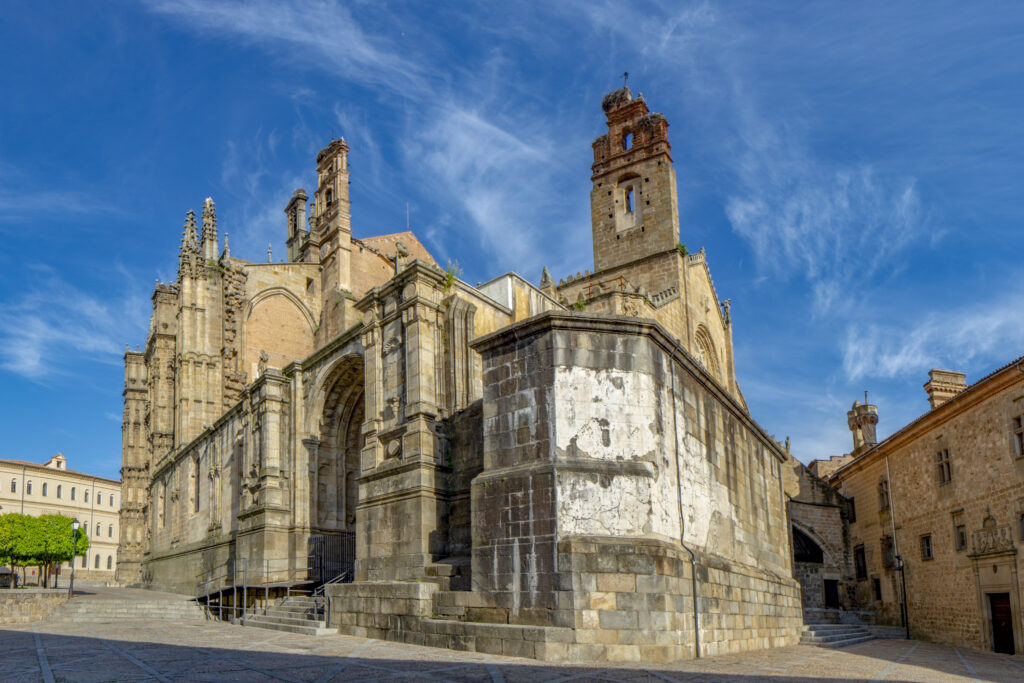
Plasencia’s population has grown steadily over the past few decades and the town now has more than 40,000 inhabitants. For over 800 years, a farmers’ market has been held every Tuesday in the Plaza Mayor, a vivid expression of Plasencia’s role as a central hub in northern Extremadura.
The Puente de Trujillo, which crosses the Río Jerte, was already crossed by the Roman highway Via de la Plata. However, the town’s famous history only began in 1186 when it was founded by Alfonso VIII. In 1212, this King of Castile and his troops inflicted a decisive defeat on the Moors in the Battle of Las Naves de Tolosa.
Plasencia quickly became a bishop’s see, which necessitated the construction of a cathedral. The first cathedral was built between the 13th and 14th centuries. Construction of a second cathedral began in the 15th century, but this was demolished in 1760. The current cathedral of Plasencia therefore consists of two churches: the old Romanesque Catedral Vieja and the new, unfinished Renaissance-style Catedral Nueva.
The Plaza Mayor with the town hall and beautiful arcades forms the center of the old town. The old city walls, the construction of which began in 1197, run around the historic center. Of the original 71 defensive towers, 21 still remain, and five city gates open the entrance to the medieval city center.
Granadilla
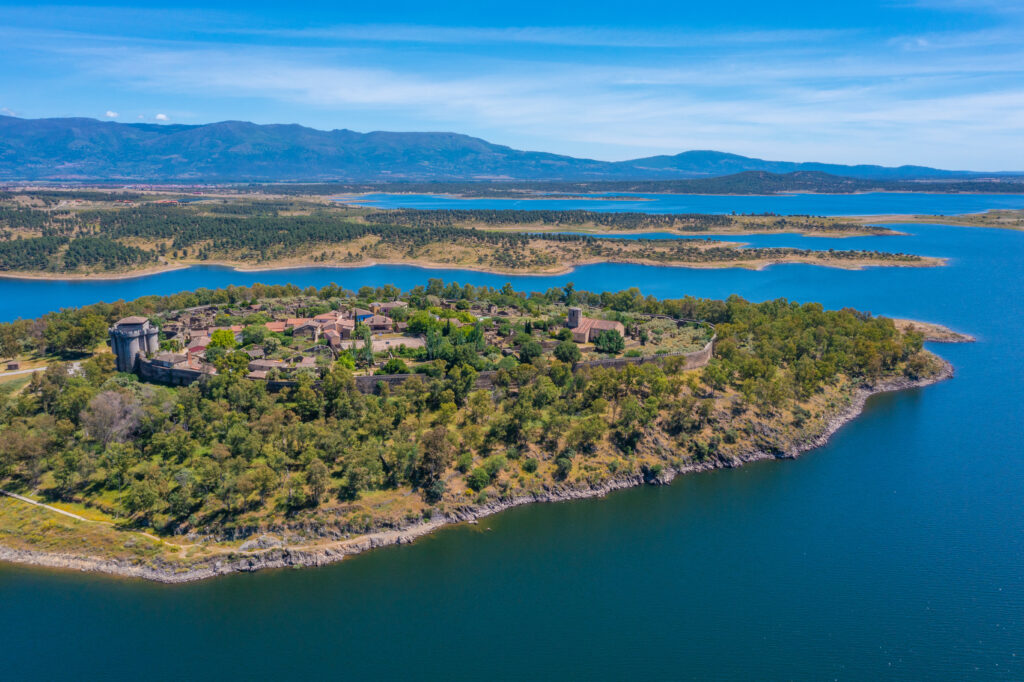
Granadilla was founded by the Arabs as early as the 9th century. The town was situated in a strategically favorable location, which enabled the inhabitants to keep an eye on the Ruta de la Plata, an old trade and travel route through the region.
In the 1950s, the then dictator Franco decided to economically revitalize the rural areas of Spain by creating numerous reservoirs. The largest of these projects was the Gabriel y Galán dam, which dammed the river Alagón to create a gigantic reservoir. In 1955, the authorities decreed that Granadilla was located in the floodplain and therefore had to be evacuated.
Between 1959 and 1969, all 1,000 inhabitants were forcibly relocated, many of them to residential areas near the town. The water began to rise in 1963 – but Granadilla was never flooded. The engineers responsible had simply miscalculated. Despite this fact, the former residents were not allowed to return to their homes and Granadilla became a ghost town.
Because the Spanish government still adheres to the flood decree signed by Franco, a return to Granadilla is still out of the question. The ghost town of Granadilla is only open to visitors during the day. It was declared a historical and artistic site in 1980. Since then, volunteers have been running it as a kind of free open-air museum.
Monastery of Yuste
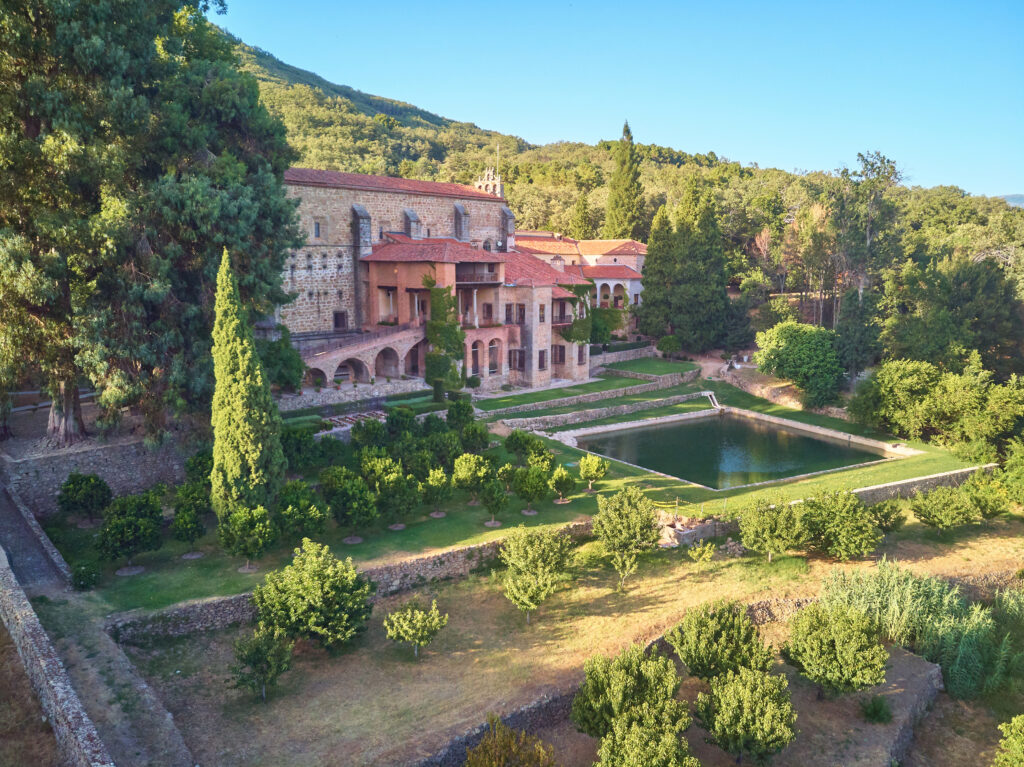
What we see today of the famous monastery of Yuste is essentially a reconstruction from ruins. This is because the buildings were destroyed down to their foundations at the beginning of the 19th century during the Spanish War of Independence.
The importance of the monastery of Yuste lies less in the religious sphere than in the secular, political sphere. It was here that Charles V spent the last years of his life in seclusion after his abdication from 1556 to 1558. Born in Ghent in 1500, the Habsburg was Emperor of the Holy Roman Empire as Charles V and King of Spain as Carlos I at the same time. He thus ruled “an empire where the sun never sets”, which stretched from Europe to America and Asia.
The monastery of Yuste was founded in 1409 by the Hieronymites, a religious order based mainly in Spain and Portugal. A small Renaissance-style palace was built next to the original monastery for the abdicated emperor. Among the sights of the complex are the two cloisters, the Gothic church and the emperor’s rooms, which still contain an armchair in which the gouty monarch received his guests.
Charles V was buried in the monastery after his death, but his son and successor as King of Spain, Felipe II, later ordered the tomb to be moved to the newly built Escorial Royal Palace in the outskirts of Madrid.
Alcantara
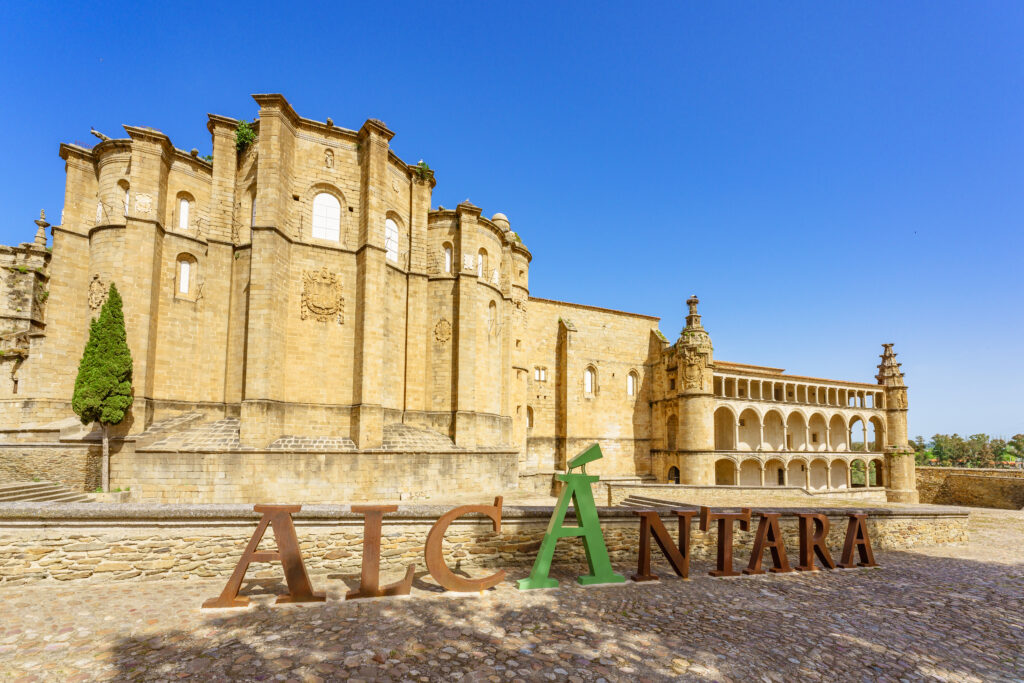
Those who come to Alcántara on an excursion or round trip often only have the oldest surviving Roman bridge in Spain as their destination. But the little town has even more to offer. You might even want to plan an overnight stay here.
The Roman bridge was built between the years 104 and 106 and crosses the Río Tajo with six arches over a length of 194 meters. It is the only Roman bridge in the world that can still be crossed by normal vehicles.
In the middle of the bridge is a triumphal arch in honor of the Roman Emperor Trajan.
From the small rest area by the bridge, two footpaths lead up to the village on the left bank past a small Roman temple: on the left, a slightly longer path with less incline past the ruins of a convent. Or on the right, directly up the slope, a steep path lined with small gardens.
Once at the top, it is worth strolling through the alleyways for a while. There are quite a few palaces to discover here. The reason for this lies in the history of the town. In 1213, Alfonso IX of León defeated the Moors. He transferred military security, administration and the associated exploitation of agriculture to an order of knights. This was later known as the Order of Alcántara.
This order was one of the four most important military orders in Spain. This gave the town important strategic and military significance.
Jerez de los Caballeros
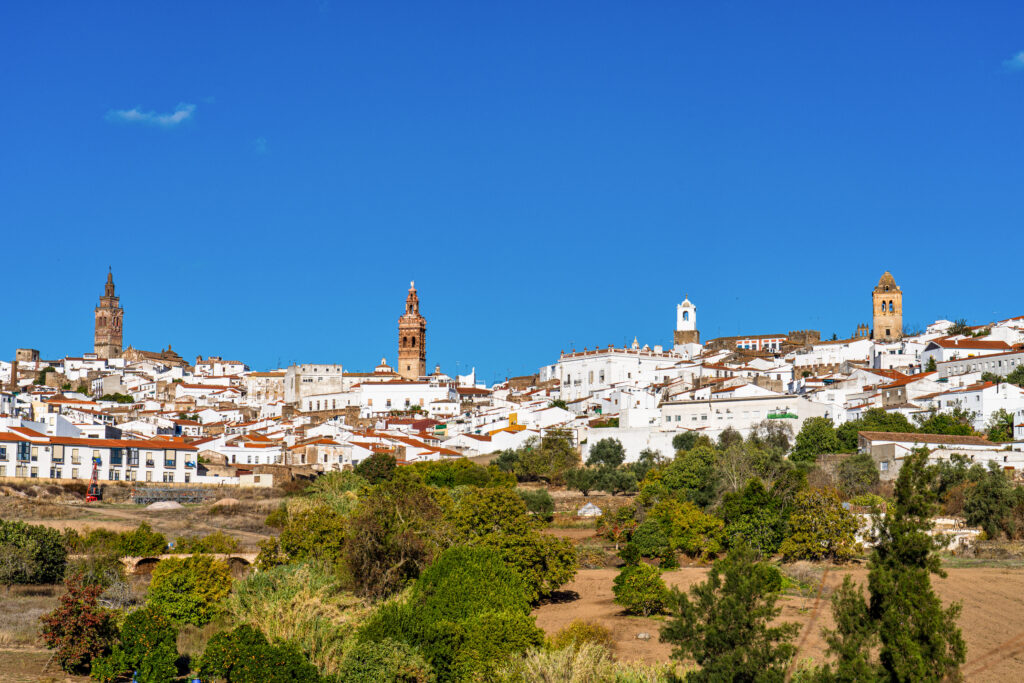
Jerez de los Caballeros, the city of knights, as the town’s name means, is one of the most beautiful small towns in Extremadura. High church towers characterize the unique townscape. Another attraction is the castle of the Knights Templar.
The small town with its almost 10,000 inhabitants is located in the south-eastern Extremadura Baja in the vastness of the Sierra. As soon as you arrive, your gaze is drawn to the high church towers, which, together with the castle, make the townscape unmistakable. The medieval town center is surrounded by a city wall with six city gates and defensive towers. As you stroll through the alleyways, you will always come across a church tower to help you find your way around.
The church of Santa María de la Encarnación is the oldest church in the city.
It was probably built in 556 on the foundations of a Gothic predecessor and has been rebuilt several times over the centuries.
The spires of the churches of San Miguel Arcangel, San Bartolomé and Santa Catalina, which are over 60 meters high, were rebuilt in the Baroque style in the 16th century after the Lisbon earthquake of 1755, the effects of which reached as far as here. During this time, the city experienced a period of prosperity.The population grew noticeably, palaces and mansions were built and the town was granted special city rights.
The fortress and the remains of the Moorish Alcazaba date back to earlier times.In 1230, Jerez was conquered by the Moors under the rule of the King of León, Alfonso IX. He gave the Order of the Knights Templar control of the town, which they exercised until their expulsion. The nickname “de los Caballeros” dates from this time.
Badajoz

The city of Badajoz is the economic center of Extremadura. The city is located on the River Guadiana just a few kilometers from Portugal. 150,000 people live in the border town, where trade with the neighboring country is of great importance.
The old Puente de Palmas bridge crosses the river from the north-west into the old town. The Puerta de Palmas marks the historic entrance to the city. In the center is the historic core with the Plaza de España and the Cathedral of San Juan Bautista. Construction of the church began in 1230 after the Christian conquest under King Alfonso IX of León.
Many small stores, bars and restaurants await visitors and guests in the surrounding area. An eye-catcher in the city center is the Giralda de Badajoz on the Plaza de la Soledad. The building, which dates back to 1935, is a miniature replica of the famous landmark of Seville.
To the north-east of the Plaza de España is the far more beautiful and older Plaza Alta on the edge of the Moorish Alcazaba. The square, decorated with arcades, was the traditional marketplace in the Middle Ages. In the background is the Moorish tower Torre de Espantaperros, built in 1169.
A walk up to the Alcazaba is not only worthwhile because of the imposing buildings, towers and fortifications. The garden offers peace and quiet and the panoramic view of the city and the surrounding area with the river landscape of the Guadiana.
Zafra
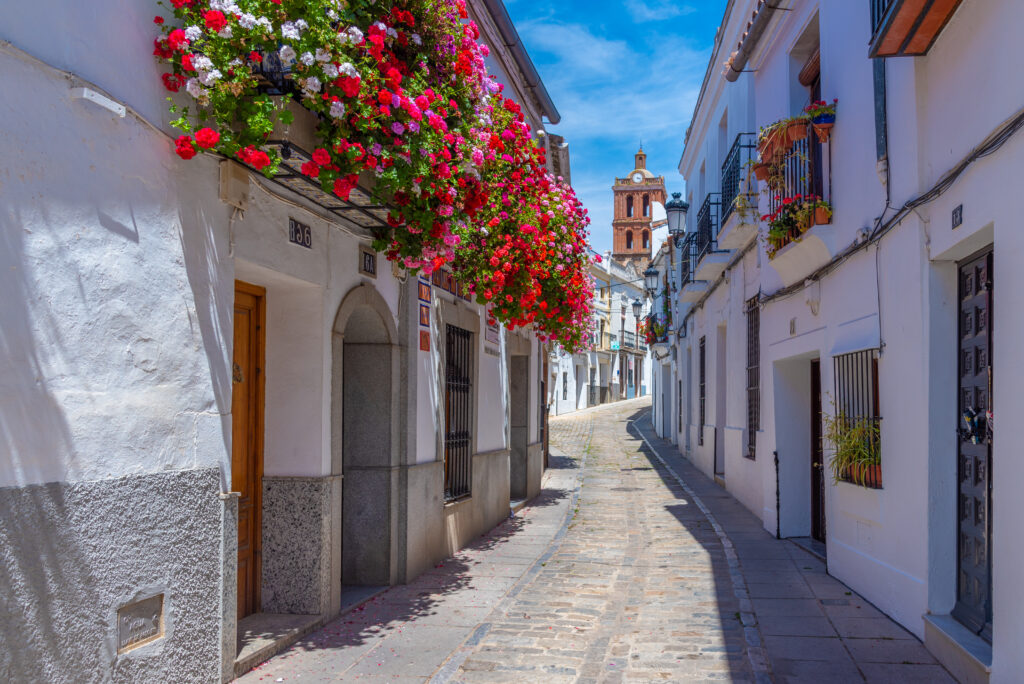
The small town of Zafra lies at an altitude of 500 meters on the edge of the Sierra del Castellar in the south of Extremadura at the crossroads of important transport routes. The town, which today has a population of just under 17,000, was founded in 1030 and for a long time was an important border town between the Moorish kingdom of Badajoz and the kingdom of Seville. In 1241, Zafra finally came under the rule of the Castilian crown.
The town is known nationwide primarily for one of the oldest cattle markets in Spain, which takes place at the beginning of October. Apart from this economic flagship, the small country town presents itself in a more tranquil manner.
The small old town between Plaza de España in the south and the squares Plaza Grande and Plaza Chica in the north, connected by the shopping street Calle Sevilla, has its charm. White houses with wrought-iron balconies adorned with flowers line the cobbled streets.
The bell tower of the parish church of Santa María de Candelaria rises imposingly above the roofs of the old town, a good orientation aid from many points along the sometimes confusing alleyways.
In addition to the monasteries, city gates and secluded squares, the Alcázar of Zafra is one of the city’s most important sights. Construction of the fortified palace, now known as the Palacio de los Duques de Feria, began in the middle of the 15th century and its basic structure was completed in just six years.
Medellin
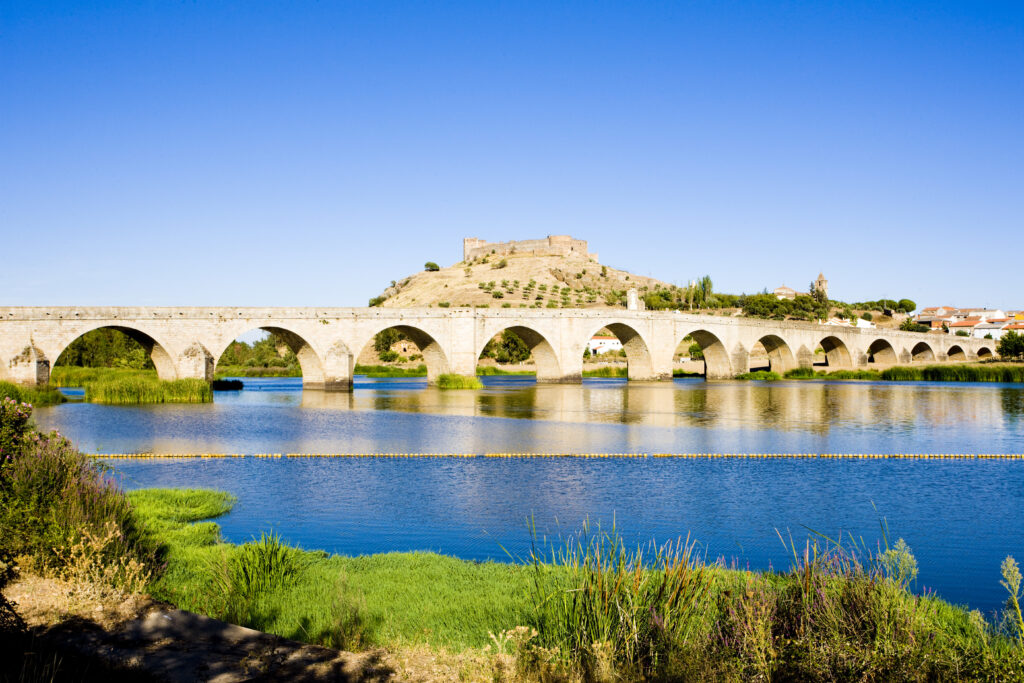
Among the main attractions of Medellin are the monuments and archaeological finds that allow you to travel back in time and discover the history and culture of the city. On the hill where the medieval castle and Roman theater stand is one of the most extensive archaeological sites in Western Europe, with remains dating from the Bronze Age to the end of the modern era, showing the many cultures that have inhabited this land.
Medellín has beautiful religious buildings, including three churches: the Church of Santiago, built in the 13th century between the castle and the urban area, where you can trace the historical development of the city; the Church of San Martín, also built in the 13th century on the remains of a Roman temple; and the 16th-century Church of Santa Cecilia, the only church in use in Medellín and named after the city’s patron saint.
Medellín also has a rich traditional architecture that invites the visitor to visit bridges and monuments such as the magnificent Austrias Bridge, the ruins of Porta Caeli, the Almohad Walls, the bridge over the Cagánchez stream, the bridge over the Ortigas River and the mill on the Guadiana River.
In the city there are also many routes and paths to enjoy the landscape and do sports. For example, you can go hiking or horse riding on the Royal Cattle Trail.
Garganta de los Infiernos
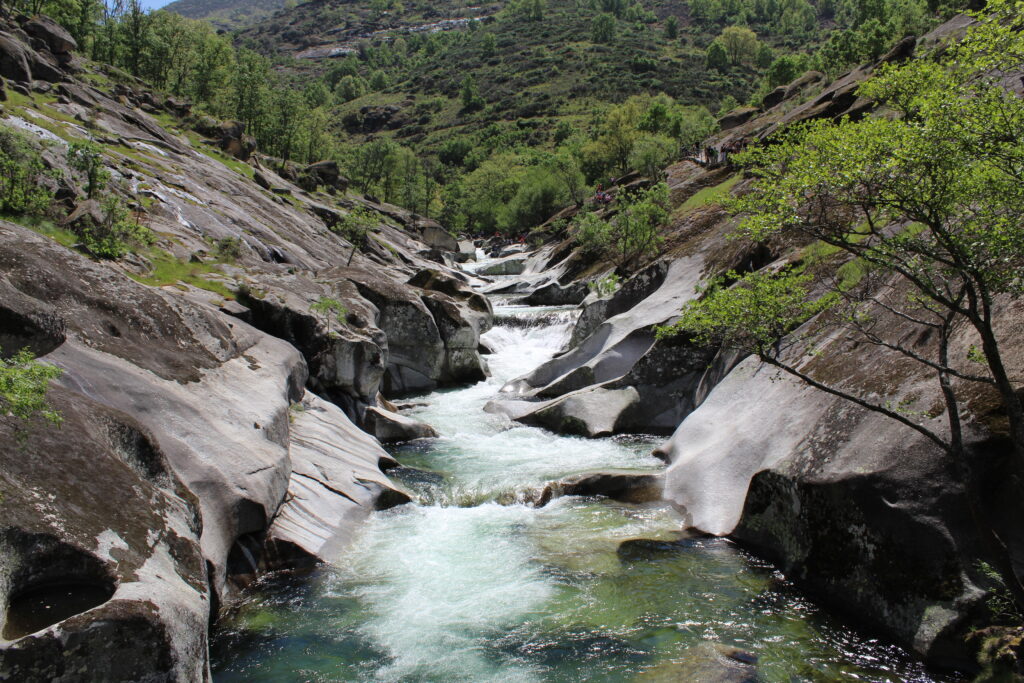
The Garganta de los Infiernos nature reserve is part of the Extremadura network of nature reserves. It consists of an area with stone pools formed by water erosion that look like bathtubs, ideal for cooling off on summer days: Los Pilones. It is ideal for a visit all year round, although the reserve has a special charm in spring: The cherry trees are in bloom and all the fauna come out of their winter hiding places.
If you come here in summer, be sure to take your swimming costume and a towel. The enclave is idyllic, straight out of a story. Its waterfalls, streams and creeks that flow into the River Jerte will make you think you’re in the middle of a dream. In addition to Los Pilones, sign up for this place: the Chorrero de la Virgen. A spectacular waterfall that you can see from your own vantage point. Without a doubt, the Garganta de los Infiernos is one of the most beautiful places in the world.
Hervas

The small town of Hervás, which is home to around 4,000 inhabitants, is located in the north of Extremadura and is the main center of the Ambroz Valley (Valle del Ambroz). The town is particularly famous for its Jewish quarter (barrio judio), which has been declared a cultural asset. There are many things to discover in the narrow and steep alleyways, such as the narrowest “street” in Spain, the Travesía del Moral.
We and many of our friends were also amazed by a private cactus farm, which was created by its owner over many years with a great deal of love and sensitivity and which is free to enter. If you let your gaze wander into the distance, you will discover a strikingly designed building complex with pointed towers above the Roman bridge. It houses one of the most important museums for classic cars and motorcycles.
Hervás is also known for its two leather stores, Hervás Piel and Novapiel, whose head offices are just a short distance from each other on the Carretera Nacional towards Baños de Montemayor. At Hervás Piel, you can even look directly over the shoulders of the seamstresses through a pane of glass.
Olivenza
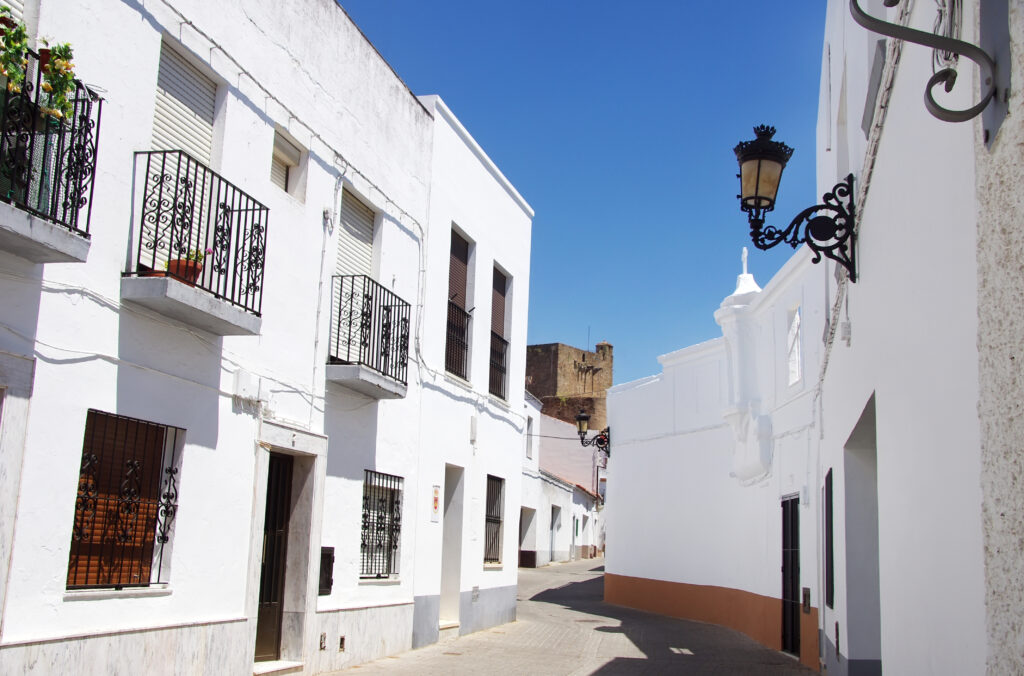
Olivenza is a pretty little town with a defensive wall, churches, orange trees and plenty of peace and quiet. It is located on the border with Portugal and is considered the most Portuguese town in Spain.
This is hardly surprising, as Olivenza, on what is now the western edge of the Extremadura region, actually belonged to Portugal for centuries, specifically from 1297 to 1801.
Accordingly, the buildings here are characterized by Portuguese art, especially the churches of Magdalena, Santa María and the nunnery of San Juan de Díos. Trademark: Blue tiles with saint motifs.
Almost nobody knows Olivenza. The 12,000 inhabitants live 25 km south of Badajoz, the slightly larger town on the border with Portugal. Today, the village in Extremadura is tranquil.
From the lookout tower of the 14th century castle, visitors have a great view of the area with its orange and olive trees.
The whitewashed facades keep out the heat and the few bars keep out the all-too-intense nightlife. But the fortified castle alone is a reminder: A fierce border war raged here in 1801, known as the Orange War.
The Spaniards recaptured Olivenza during the military scuffle.
Portugal was the loser. But the Portuguese culture survived. Even in the 19th century, the inhabitants of the small town and the villages in the surrounding area only spoke Portuguese.
Jerte Valley
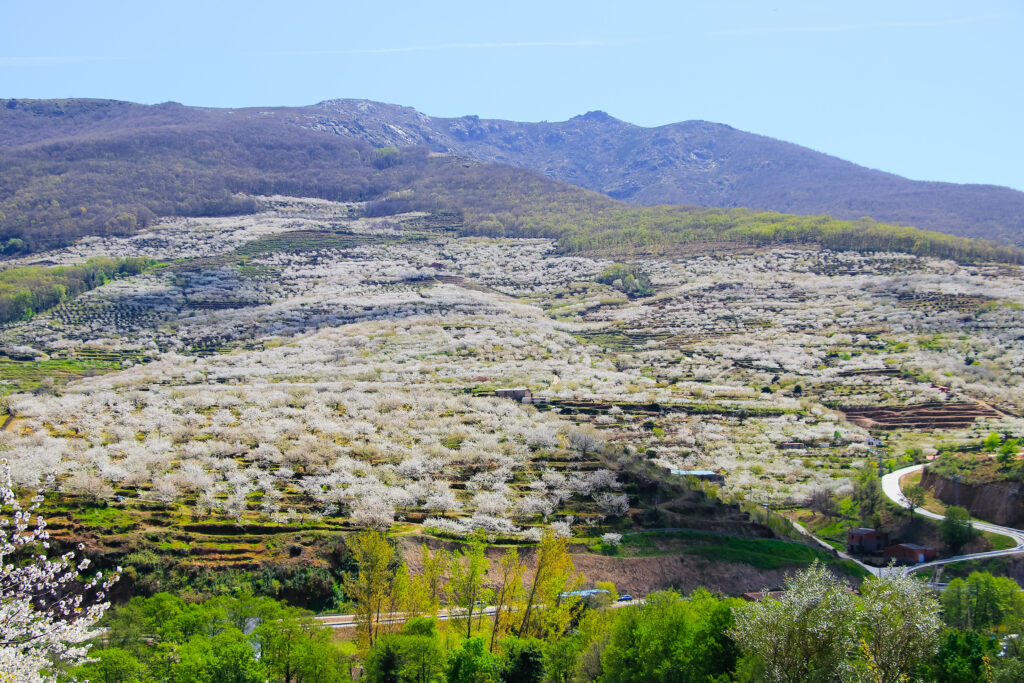
What makes the Valle del Jerte so special?
Two million cherry trees crowd the mountain slopes, covering the area in a sea of white and pink hues when they blossom in spring at an altitude of 1275 meters. Around 200 different varieties of cherry are grown here. The valley opens up in a particularly spectacular way if you travel from the east towards Madrid: from the Puerto de Tornavacas viewpoint.
In the surrounding area there are nature reserves where the Iberian lynx still lives, in the higher regions there are vast oak forests and even snow-covered mountain peaks. Medieval villages nestle against the mountains. The largest town in the area is Plasencia, which has so far attracted few tourists. Here you can stroll through enchanted labyrinths of alleyways and stop for a bite to eat in the numerous tapas bars.
When is the best time to visit the Valle del Jerte?
In spring, of course, when the flowers are in bloom. This is at its peak from the end of March to mid-April. But a visit is worthwhile all year round. There is a microclimate that ensures mild temperatures in both summer and winter.
Alburquerque
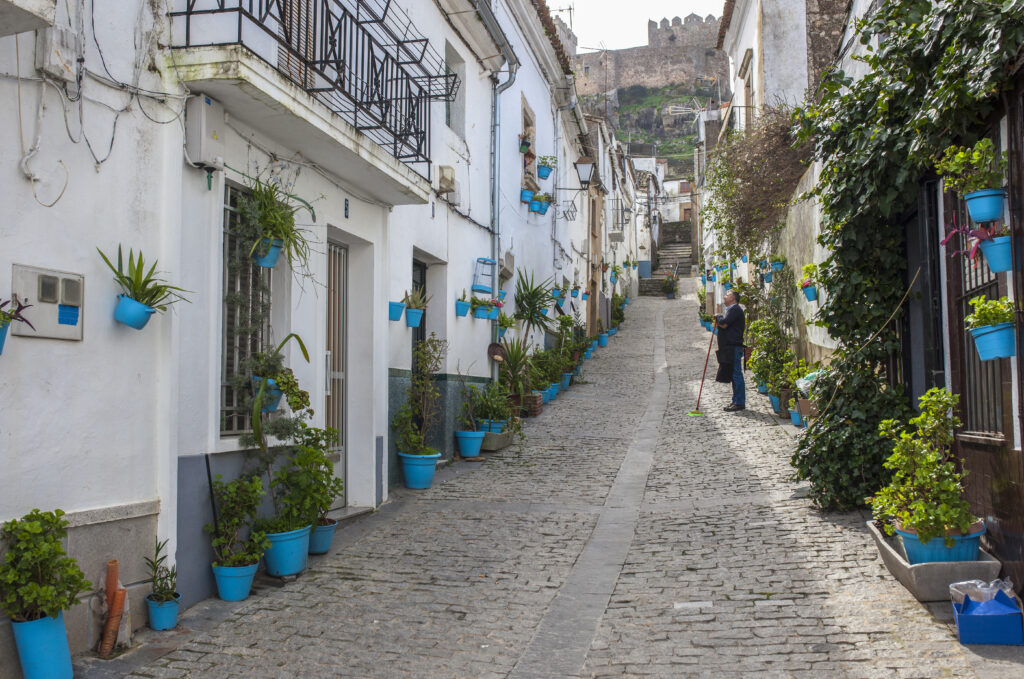
The small town of Alburquerque, with its medieval city walls up to ten meters high, is a picturesque destination. It is located in the foothills of the Sierra de San Pedro not far from the border with Portugal. The landscape around the town is characterized by cork oaks, which are the basis for a strong cork industry in the region.
The historic town center within the city walls is ideal for a leisurely stroll through the town and exploring various historic buildings. The Plaza Major, the central square with its historic architecture and cozy cafés, is a great place to take a break and enjoy tapas or Iberian ham. Another highlight is the medieval castle Castillo de Luna above the city with its keep and Siete Picos tower. Its roots date back to the 13th century, while its current appearance dates back to the 15th century.
Coria
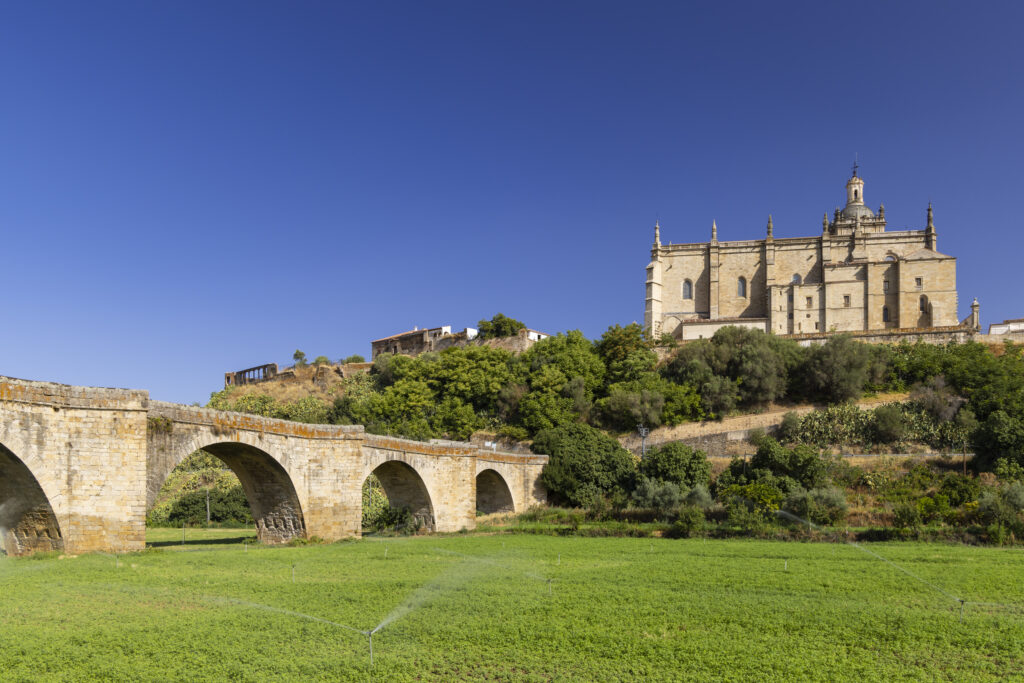
Its stone bridge, a secular building in the Renaissance style, has been crossing a dry riverbed since 1590. At that time, the Alagón changed its course due to a severe flood.
Coria looks back on a Roman and Moorish past. Its city wall, which has twenty square towers and four city gates, is a wonderful example of Roman defensive architecture from the 2nd and 4th centuries and has various funerary steles carved into the walls. Of the castle, which dates back to the 15th century, the main tower and the adjoining defensive building, the so-called “Castillejo”, still stand today.
The cathedral has a wide variety of styles due to its long construction phase, which began in the 15th century in the Gothic-Renaissance style. Just a few meters away is the so-called Seminario Mayor, a building from the 17th century in which the remains of a Roman burial monument can still be seen.
Other important sights include the 15th-century Madre de Dios convent, which stands within the city walls, the Bishop’s Palace built in 1626, the 16th-century Church of Santiago, in which you can admire a Mannerist reredos from the 16th to 18th centuries, the Royal Prison, which is now home to the Municipal Museum, the ecclesiastical prison built in 1760 and a botanical garden just outside the city.
Los Barruecos
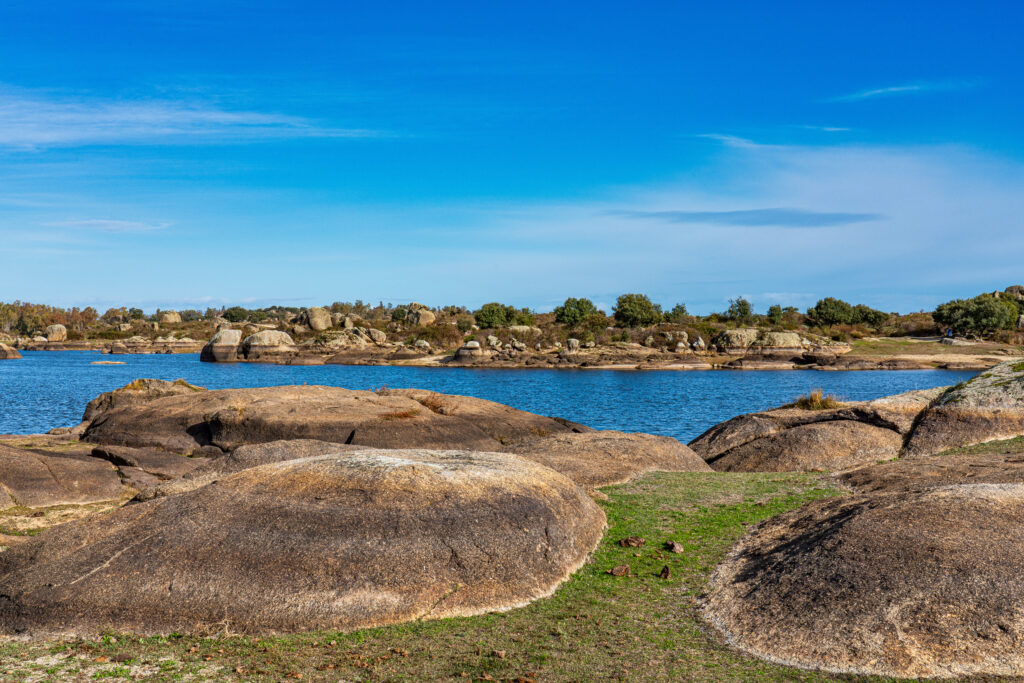
To the west of Cáceres are two different but interesting destinations that are well worth a trip or detour: An art museum in a picturesque natural park not far from the village of Malpartida de Cáceres.
The charm of Los Barruecos Nature Park lies in the fact that we can get to know some of the typical natural features of Extremadura in a small area. Brown and white horses graze on the green pastures. In spring, every suitable place that the storks consider suitable for building a nest is occupied.
The nature reserve is characterized by the human design of the landscape. The two large ponds Charca del Barrueco de Abajo and Charca del Barrueco de Arriba were artificially dammed. They were used to operate water mills. Later, the water supplies were also used to wash the wool from the flocks of sheep. The wool industry played an important economic role in Extremadura in the 18th century. The historic main building now houses the Museo Vostell Malpartida.
However, the nature park now has another attraction to offer. The park’s landmarks are the rounded granite rocks scattered across the landscape. Some of these granite boulders lie alone as spheres in the area, others are piled up to form rock towers. Prehistoric settlement remains have been found on the mighty Peñas del Tesoro (Treasure Rock), where storks like to build their nests today.

